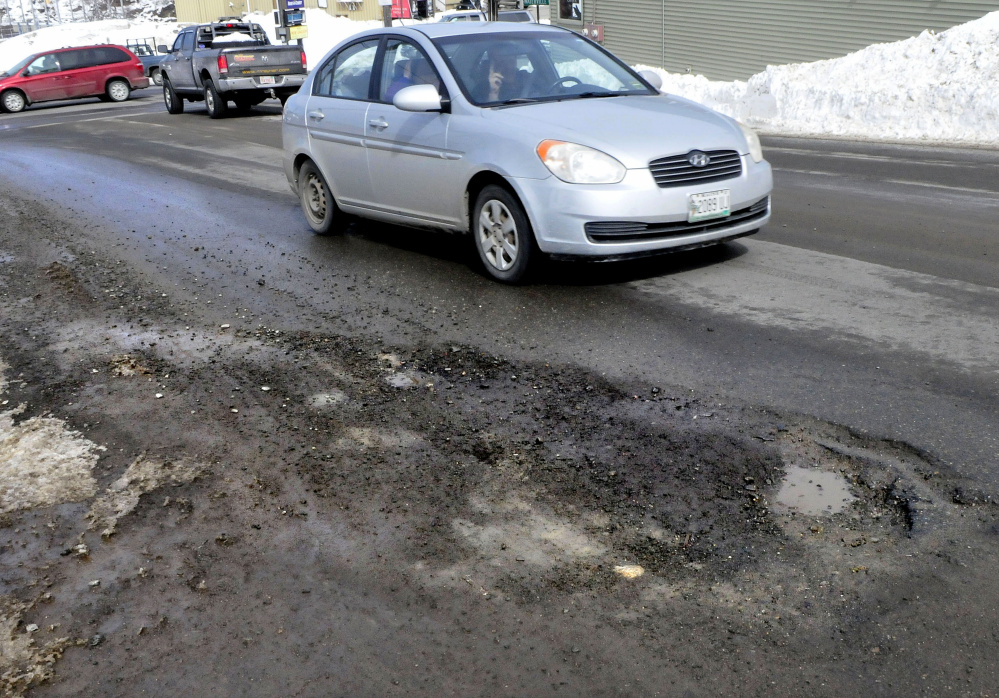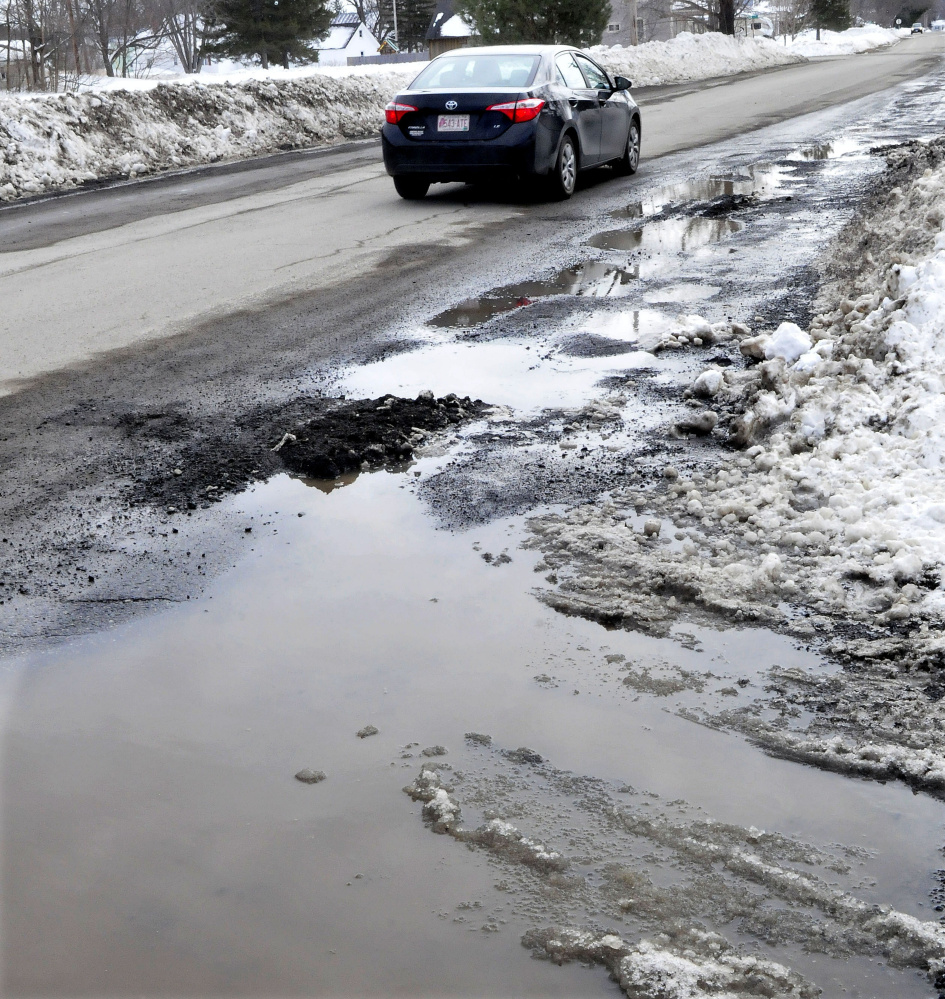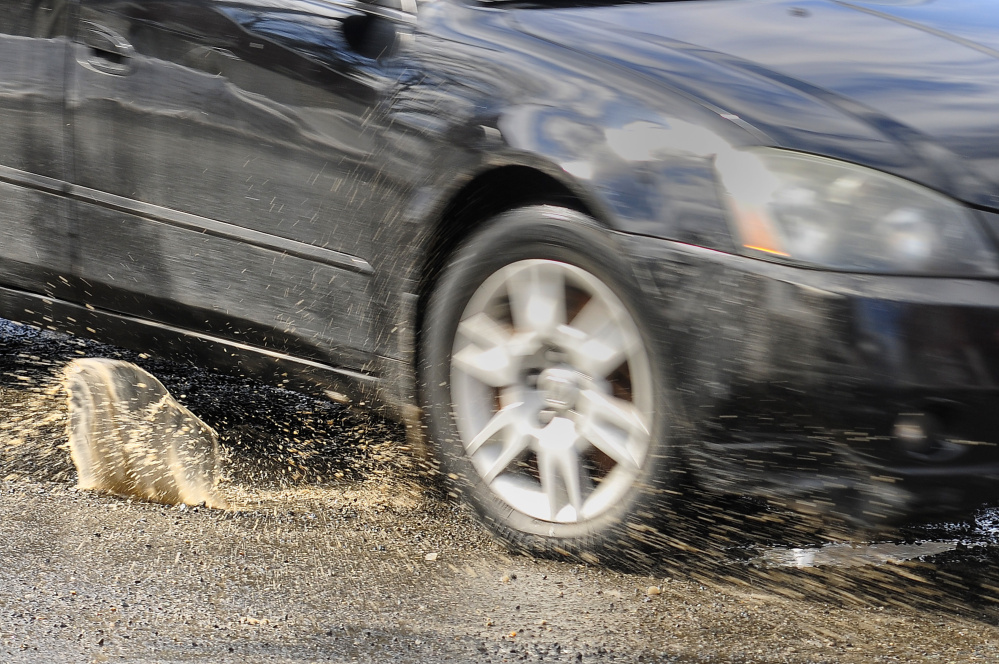Public works officials in central Maine say the late winter’s recent thawing, followed by plunging temperatures and a blizzard last week, have exacerbated pothole problems across Kennebec County and the region.
“This is a bad year for us; we’ve had a lot more problems than usual,” said Skowhegan Road Commissioner Greg Dore. “Roads are starting to crack and fall apart.”
The culprit is the freeze-thaw cycle, public works directors say, and while crews try to keep up with the road hazards that crop up regularly, it’s an annual battle and a rite of early spring, which arrives Monday
In southern Kennebec County, Gardiner Public Works crews have been filling potholes with temporary patching materials as drivers report them. Gardiner Public Works Director Tony LaPlante said the cycle of rain and freezing that came earlier this winter has forced crews to return several times to the same heavily traveled areas.
He called one prominent pothole at the intersection of the heavily traveled Water and Bridge streets a “frequent flier” for crews. Although they have applied a short-term, cold-weather patch to the hole several times, those patches come off when water gets underneath and freezes. His crews also make frequent repairs on Maine Avenue, the road that connects Gardiner to Farmingdale and Hallowell.
“We fill ’em as quickly as they become evident,” LaPlante said. “We’re just trying to get by until spring.”
Crews have to balance the needs of keeping potholes at bay against the risk that more snow could fall, LaPlante said.
BLIZZARD ADDED TO PROBLEM
Potholes are not unique to Gardiner. Across the region, public works crews are doing battle with the bane of drivers everywhere it’s cold in the winter.
Waterville Public Works Director Mark Turner said the city has a few areas with significant pothole problems. In particular, he said the upper section of Main Street toward Interstate 95 has been the source of complaints.
“That’s been our biggest problem area,” Turner said, while noting that a few sections of Spring Street had also been nuisances in terms of potholes. Both streets are owned by the state, he said, and are scheduled for summer repair work.
Streets and roads fall into disrepair in the spring because of thawing and moisture from melting snow getting into cracks in the road, Turner said. When the water re-freezes it expands, enlarging cracks or lifting the pavement and opening the door to potholes.
The mid-March blizzard that struck the state Tuesday did not do the streets any favors. The snow leads to more freezing and thawing and more plow trucks traveling the roads. As a result, Turner said crews will patrol the problem areas searching for places that need repair.
In addition to Main Street and Spring Street, Turner said Gilman Street is also a problem area for potholes, and is also scheduled for summer repairs by the state. Hazelwood Avenue and the Concourse were also noted as problem areas.
But Turner said crews check roads regularly.
“Throughout the city it’s sporadic. We try to get to all of them as we can,” he said.
So far this winter, Dan Brooks, the service manager at Capitol Car Care in Augusta, said he hasn’t noticed many serious accidents involving potholes.
COLD PATCH ONLY A SHORT-TERM FIX
While it’s tempting to seek redress from cities and towns for pothole-induced damage, state law says the damage is not the responsibility of cities or towns as long as a municipality addresses the pothole within 24 hours of being notified of its existence. Turner said that law protects cities and towns, but it does not apply if a city is doing some kind of renovation to the road and leaves it in disrepair or poor condition; it applies only to conditions caused naturally.
In Skowhegan, roads have been hit hard this winter, especially after the recent storm, said Dore, the road commissioner.
“We definitely have our fair share of potholes,” Dore said. “When it snows and the salt melts it and when the cold patch gets wet like that, it gets in the potholes and it pounds back out again.”
He said his road crews did some cold patching of potholes a few days before last week’s snow, and now have to go back out to refill the holes with more cold patch.
“It’s a vicious cycle,” he said. “Once we can get some hot top on the roads we’ll be able to fix them right so they’ll last, but this time of year all you can do is cold patch.”
He said his crews are constantly playing catch-up with potholes. Bad spots in Skowhegan include Greenwood Avenue that leads to the highway department, where the edge of the road heaved so melting snow can’t get to the catch basins. Other areas include East River Road and Madison Avenue by the entrance to Wal-Mart.
Dore said there is a product called aqua pavement or aquaphalt – compounds of asphalt and concrete – that works very well on heavily traveled areas, but it is also very expensive.
His crews use reclaimed, ground-up asphalt from summer paving jobs as an inexpensive alternative to cold patch.
Staff writers Doug Harlow and Colin Ellis contributed to this report.
Charles Eichacker can be contacted at 621-5642 or at:
ceichacker@centralmaine.com
Send questions/comments to the editors.






Success. Please wait for the page to reload. If the page does not reload within 5 seconds, please refresh the page.
Enter your email and password to access comments.
Hi, to comment on stories you must . This profile is in addition to your subscription and website login.
Already have a commenting profile? .
Invalid username/password.
Please check your email to confirm and complete your registration.
Only subscribers are eligible to post comments. Please subscribe or login first for digital access. Here’s why.
Use the form below to reset your password. When you've submitted your account email, we will send an email with a reset code.